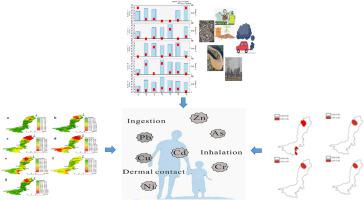Ecotoxicology and Environmental Safety ( IF 6.8 ) Pub Date : 2021-09-08 , DOI: 10.1016/j.ecoenv.2021.112752 Weibo Shen 1 , Yue Hu 2 , Jie Zhang 2 , Fei Zhao 3 , Pengyang Bian 2 , Yixuan Liu 2

|
The content of Cd, Cu, Pb, Zn, Cr, Ni and As from 250 soil samples was measured in agricultural soil of Ningxia section of the Yellow River. Positive matrix factorization (PMF) was to identify the main sources of these heavy metals; Sequential Gaussian Simulation (SGS) was to identify their spatial distribution and high-risk areas; and Human Health risk (HHR) model was to measure the health risk. Results showed that the average content of Cd and As exceeds the risk screening value of "Soil Environmental Quality-Agricultural Land Soil Pollution Risk Control Standard" (GB 15618-2018), which belongs to slight-level pollution. Although the content of other types of HMs (Cu, Pb, Zn, Cr, Ni) is below the risk screening value, they are still included heavily in the soil (except Cr). PMF indicated that mixed sources of agriculture and industry accounted for 27.06%, natural sources accounted for 14.12%, industrial sources accounted for 23.04%, traffic sources accounted for 21.50%, and Yellow River sedimentary sources accounted for 14.28%. PMF-HHR showed that the mixed sources of agriculture and industry are the most important factor causing non-carcinogenic risk (HI) to children (accounting for 55.75%). Industrial sources and traffic sources were the two main factors that cause HI to adults (industrial sources accounted for 25.16%, and traffic sources accounted for 28.78%). Mixed sources of agriculture and industry and natural sources were the two main factors that cause carcinogenic risk (CR) (mixed sources of agriculture and industry account for 35.34%, and natural sources account for 33.23%). SGS indicated that 0.64% and 9.32% of the total areas were posing as higher HI areas to children and adults respectively; in particular, 0.68% and 1.12% of the areas were identified as higher HI of As and Cr areas at a critical probability of 0.9.
中文翻译:

基于序贯高斯模拟和正矩阵分解模型的土壤重金属空间分布及人体健康风险评估——以黄河灌区为例
在黄河宁夏段农田土壤中测定了250份土壤样品中Cd、Cu、Pb、Zn、Cr、Ni和As的含量。正矩阵分解 (PMF) 是为了确定这些重金属的主要来源;序列高斯模拟(SGS)用于识别其空间分布和高风险区域;人类健康风险(HHR)模型用于衡量健康风险。结果表明,Cd和As的平均含量超过了《土壤环境质量-农业用地土壤污染风险控制标准》(GB 15618-2018)的风险筛选值,属于轻度污染。尽管其他类型的重金属(Cu、Pb、Zn、Cr、Ni)的含量低于风险筛选值,但它们仍大量存在于土壤中(Cr 除外)。PMF显示,农工混合源占27.06%,天然源占14.12%,工业源占23.04%,交通源占21.50%,黄河沉积源占14.28%。PMF-HHR显示,农业和工业的混合来源是造成儿童非致癌风险(HI)的最重要因素(占55.75%)。工业源和交通源是造成成人HI的两个主要因素(工业源占25.16%,交通源占28.78%)。工农业混合源和天然源是导致致癌风险(CR)的两个主要因素(工农业混合源占35.34%,天然源占33.23%)。SGS 表示 0.64% 和 9. 32% 的区域分别对儿童和成人构成了较高的 HI 区域;特别是,0.68% 和 1.12% 的区域被确定为 As 和 Cr 区域的 HI 较高,临界概率为 0.9。



























 京公网安备 11010802027423号
京公网安备 11010802027423号